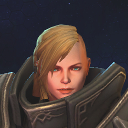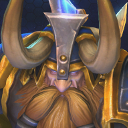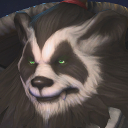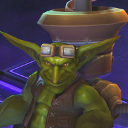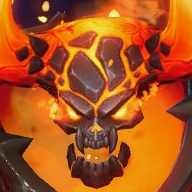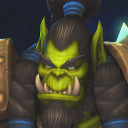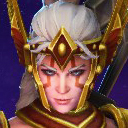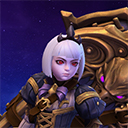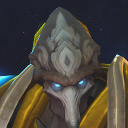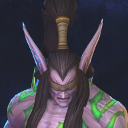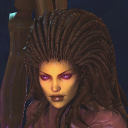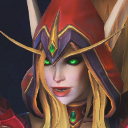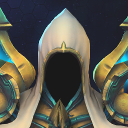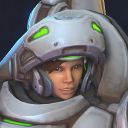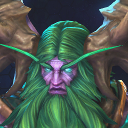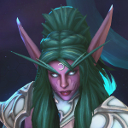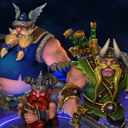The Lost Vikings Build Guide “We're lost again!”
Welcome to our guide for The Lost Vikings, a Support in Heroes of the Storm. Within these pages, you will find everything required to understand how best to play this hero, in both different map styles and team compositions.
The Lost Vikings' Overview
The Lost Vikings, also commonly referred to as TLV, are an assembly of three individual characters that compose a rather unique support. TLV's primary strength is their ability to split up and generate meaningful impact on the battlefield throughout multiple locations. This impact primarily consists of soaking experience from minion deaths in multiple lanes simultaneously creating potential for a massive team level advantage. The Vikings are also capable of applying enormous amounts of lane pressure by means of isolated wave clear and constant control of key mercenary camps while the enemy may be distracted with different objectives or rotations. Managing three individual characters with relatively small health pools and lack of escape does provide TLV players a challenging high-risk high-reward play style. When these little guys are utilized effectively they tend to be not only a frustrating annoyance for your opponent, but ultimately prove themselves worthy of being considered a massive threat.
The Lost Vikings' Strengths and Weaknesses
Large experience gains through soaking multiple lanes
Forces opponents into trading lane presence, minion experience, and structures for objectives due to Vikings multiple lane pressure
Baleog's splash damage based auto-attacks provide good waveclear
Excellent at clearing and maintaining control of Mercenary Camps, especially upon choosing the
 Viking Bribery at Level 1
Viking Bribery at Level 1Erik can easily harass enemies trying to channel an objective
Relatively difficult to play with a very steep learning curve
Each Viking has an especially low health pool, allowing them to be easily picked off
Very susceptible to ganks, particularly when overextending to pressure a lane
Requires constant map awareness, and a very thorough understanding of each battleground and its particular objective mechanics
Incredibly dependent on team communication
Can be easily counter-picked by heroes that deal large amounts of single target damage such as Zeratul or Falstad
Very weak early game while your opponents are still in lane. Usually the case until an important battleground objective requires contesting
The Lost Vikings' Talent Build Cheatsheet
Standard Build
RecommendedStandard Build should be the option to go for in most matches. It not only
improves Vikings' split-push, but is also decent
in teamfights. ![]() Erik the Swift and
Erik the Swift and ![]() Large and In Charge
will enable constant harass by Erik, while giving a good crowd control
to Olaf, which is much needed.
Large and In Charge
will enable constant harass by Erik, while giving a good crowd control
to Olaf, which is much needed.
![]() Olaf the Stout is the standard choice on its tier,
but
Olaf the Stout is the standard choice on its tier,
but ![]() Viking Bribery can be good in maps with good
Siege Mercenary Camps, like in Cursed Hollow or Garden of Terror.
Viking Bribery can be good in maps with good
Siege Mercenary Camps, like in Cursed Hollow or Garden of Terror.
The Lost Vikings' Synergies and Counters
The Lost Vikings do not need allies to help them to do their job (getting all the possible experience and Mercenaries). It will be better to draft Heroes with great pushing potential, or that have excellent lane presence to easily push as 4, while Vikings handle all the soak.
The Lost Vikings are countered by 3 kinds of Heroes:
- Heroes that can easily kill vikings from stealth, such as Zeratul or Nova;
- Heroes with good damage on towers and forts, such as Zagara or Greymane;
- Global Heroes with decent waveclear, such as Dehaka or Falstad, since they can easily double soak while having great impact in teamfights.
They are also countered by Heroes with reset mechanics, like Genji or Li-Ming.
The Lost Vikings' Maps
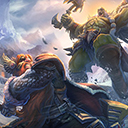

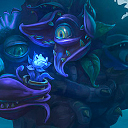











As The Lost Vikings work best as split pushers, they have a hard time on two-lane maps. The Lost Vikings are especially effective on three-lane maps that provide numerous objectives at once, such as Sky Temple or Towers of Doom.
The Lost Vikings' Tips and Tricks
- Stick with a passive playstyle in the early game so as not to miss out on minion experience or Regeneration Globes because of a Viking's death.
- When the opportunity arises, try to stack the damage of
 Spin To Win! on a single target to maximize the Vikings damage potential.
Spin To Win! on a single target to maximize the Vikings damage potential. - During teamfights, Olaf's slow or stun from his charge should be used to provide peel for allied assassins. It can also be used to stun squishy enemies, if there is no threat towards your backline.
- Try to never stack the Vikings too closely during teamfights in order to not be immediately wiped by deadly AoE abilities such as Gazlowe's
 Grav-O-Bomb 3000 or Kael'thas's
Grav-O-Bomb 3000 or Kael'thas's  Living Bombs.
Living Bombs. - In the mid-to-late game when a single Viking is pressuring the enemy teams structures, an individual enemy Hero can be baited away from important teamfights using
 Play Again!.
Play Again!. - Always be trying to integrate the ability to queue actions using the "Shift" key into your TLV play, as this will greatly increase the efficiency of your micro-managing.
The Lost Vikings' Role in the Current Meta
The first step to understanding The Lost Viking's role as a three character support is understanding the specific role of each individual Viking. The three Vikings that make up TLV are Olaf "The Stout", a tankier melee character, and Baleog "The Fierce" and Erik "The Swift" who both have ranged attacks.
Although Olaf is without a doubt the "tankiest" of the three Vikings, do not
be deceived into thinking that Olaf's primary purpose is to tank for your team.
Olaf should be seen as more of an off-tank during teamfights over objectives.
Throughout the entire match, and more particularly after having talented into
![]() Large and In Charge at Level
16, Olaf's focus should be on peeling for his
damage-dealing Assassins. Olaf is the Viking who should be present at almost
every objective-based teamfight, such as those over Cursed Hollow's tributes or
Dragon Shire's shrines. Due to his lack of damage and limited utility, Olaf
should not be used to dive the backline of the opposing team unless there is
particular reason, such as interrupting a
channeled ability like
Kael'thas'
Large and In Charge at Level
16, Olaf's focus should be on peeling for his
damage-dealing Assassins. Olaf is the Viking who should be present at almost
every objective-based teamfight, such as those over Cursed Hollow's tributes or
Dragon Shire's shrines. Due to his lack of damage and limited utility, Olaf
should not be used to dive the backline of the opposing team unless there is
particular reason, such as interrupting a
channeled ability like
Kael'thas' ![]() Pyroblast.
Pyroblast.
The second Viking of the crew is Baleog. Baleog's specialty is pushing in
minion waves with his splash damage dealing ranged auto-attacks. Baleog is
generally most effective when in lane soaking minion experience and collecting
regeneration globes to accumulate stacks of
![]() Viking Hoard.
Viking Hoard.
Erik, the third and final Viking of the lost trio, is generally considered
the favorite of the bunch by most TLV players. Erik's most useful quality is
his heighten Movement Speed, allowing him to zip around the battlefield pushing
in a minion lane at one moment and sneaking a mercenary camp the next. As long
as he is somewhat nearby, Erik should be the Viking used to stall or capture
channeled objectives. Talenting into
![]() Erik the Swift at Level 4 will greatly increase Erik's
survivability and harass capabilities, being able to constantly cancel the channeling of
a Towers of Doom altar.
Erik the Swift at Level 4 will greatly increase Erik's
survivability and harass capabilities, being able to constantly cancel the channeling of
a Towers of Doom altar.
In terms of team composition, it is important to let your team know of your intentions to select TLV before they decide on their heroes. TLV generally works best with a more "traditional" team composition, consisting of a main tank, healer, and at least one sustained damage dealing assassin. The idea is to select heroes who have good sustain, or the ability to maintain team fights over objectives for longer durations. This involves selecting healers who have a steady uptime of heals or damage mitigation such as Malfurion. We do not recommend getting squishy melee assassins with Vikings, since they will have a hard time killing enemies team fights with your allies being down a player, because TLV will most often be split-pushing lanes and soaking experience to gain a team level advantage. Due to the disadvantage in player number for your team during some objective based team fights, it may also be a good idea to include a long range caster who can poke the enemy away from capturing specific objectives, such as altars on Towers of Doom or Tributes on Cursed Hollow. This stalling and sustaining of team fights by your allies distracts the enemy and allows TLV to be even more effective in locking down the rest of the battleground. It is very important that your team is aware of when you will and will not be available to group for objectives as it will allow them to make a wiser decision as to when to engage or simply trade the objective for some other advantage.
Changelog
- 04 Jun. 2021 (talents page): Updated Talents after May 18 balance patch.
- 04 Jun. 2021 (this page): Guide updated after May 18 balance patch.
- 25 Jan. 2021 (talents page): Updated Builds and Talents.
- 25 Jan. 2021 (this page): Updated Standard Build.
- 21 Oct. 2020 (talents page): Updated Nordic Attack Squad's discussion.
- 04 Jun. 2020 (talents page): Updated builds and Talents to reflect recent balance patch.
- 21 May 2020 (this page): Changes to guide to ensure meta relevance.
- 12 Apr. 2020 (talents page): Updated builds and Talents to better reflect current meta.
- 24 Mar. 2017 (this page): Minor detail about Olaf's Role in the Current Meta noted.
- 25 Jun. 2016 (this page): Guide added.
More Support Guides
Derenash has been playing Heroes of the Storm since 2015 and has achieved Grandmaster in multiple seasons, peaking at Top 1 in Season 3 and 4 of 2018. He participated in the HGC Copa America in 2018 where his team had a strong victory. He is passionate about teaching others about the game, and streams often on Twitch in Portuguese, and you can find him in Wind Striders' Discord as well where he is happy to answer any questions in English or Portuguese.
- Heroes of the Storm Live Patch Notes: July 29
- Heroes of the Storm PTR Patch Notes: July 1
- Blizzard Celebrates 10th Heroes of the Storm Anniversary with Free-to-Play Heroes and Gear Head Thrall Skin
- Heroes of the Storm Live Patch Notes: May 15
- Heroes of the Storm PTR Patch Notes: April 26th
- Heroes of the Storm Joins Game Pass with 30 Free Heroes
- Heroes of the Storm Live Patch Notes: March 12th
- Heroes of the Storm PTR Patch Notes: February 21
- Heroes of the Storm Hogger
- Heroes of the Storm Tyrael
- Heroes of the Storm The Lost Vikings
- Heroes of the Storm Nova
- Heroes of the Storm Sgt. Hammer
 Free Hero Rotation
Free Hero Rotation






